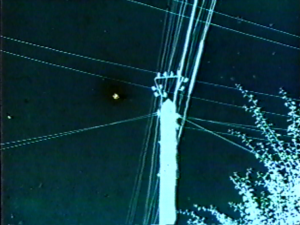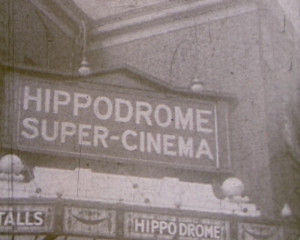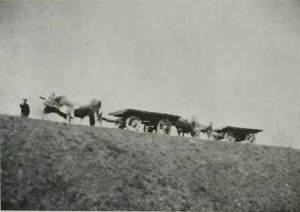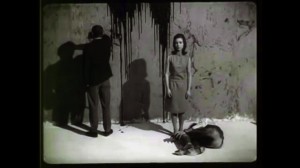"Recessional is a bit of animation drawn directly on a piece of white film using a variety of colors and set to music by the Beatles" PSA Journal, Aug. 1967, 37.
"An unusual experiment in form, motion and color. It was obtained by filming light patterns created on a translucent screen. The use of spotlights, reflectors, prisms, color filters and various home made gadgets, plus a background of organ music provides an interesting departure from conventional filming." PSA Journal, Dec. 1955, 35.
"Red Type is a novelty in animation. To describe the film would rob the viewer of much of the surprise element which adds a lot to the entertainment value of it. Let's just say this little gem was made from A to Z on a typewriter, both visually and audibly" PSA Journal, Sept. 1965, 51.

"The little-known experimental film residue 2 credited to one "Angus Hanson," was probably made in 1940s Vancouver or Toronto. (No specific landmarks from either city have been identified.) "Angus Hanson" may have been a pseudonym used by film buff and cineaste Oscar C. Burritt (1908-1974), who worked in Vancouver film before moving to Toronto in 1947. He later worked for CBC Television in Toronto, where he also co-founded, and was very active in, the Toronto Film Society. residue 2 is similar (in content, style and technique) to the experimental film "and-" [ca. 1940-41], made in Vancouver by Dorothy Fowler and Margaret Roberts. Both films combine found footage with hand-painted and scratched film stock. (Note: Oscar Burritt married Dorothy Fowler in January 1942.)"--D.J. Duffy, 2025
"Experimental film. A collage film combining found footage (on mixed film stock) with hand-painted stock and hand-scratched stock leader. No readily identifiable locations are shown." (BC Archives)
"The authorship and origins of this unusual film are not clear. Since it was found in the collection of cineaste Oscar C. Burritt [following his death], it is assumed to have been made by him as a response to the [experimental] film and-, made by his future wife Dorothy Fowler [Burritt]. The Kodachrome stock in the original film has the edge code for 1938; the hidden phrase "Help the people of Denmark" may refer to the Nazi occupation of that country in 1940." (BC Archives)
Some of the found footage used in residue 2 resembles scenes from Oscar Burritt films, including "Three There" and "[Pier D fire, Vancouver]". (D.J. Duffy, 2025)
"A black-and-white silent animation, which Kaneko himself described as a visualization of a musical score, Hungarian Rhapsodie. He experimented with visual geometric abstraction as a means to express the musical score, and this film was his first attempt to use the koma-otoshi technique (the technique being used for time-lapse photography or stop-motion animation)." - Noriko Morisue, "Filming the Everyday: History, Theory, and Aesthetics of Amateur Cinema in Interwar and Wartime Japan" (Yale University: PhD Dissertation, 2020): 99.

"Amateur filmmaker, cinema historian and railway engineer H.A.V. Bulleid pays tribute to his dual loves of cinema and rail in an experimental short film. Bulleid uses 'metric editing' - the first of Russian director Sergei Eisenstein's 'methods of montage' - in which cuts are dictated by the number and sequence of frames, not what occurs on screen. First, Bulleid pays tribute to cinema, featuring the facades of picturehouses around Derby in static shots, which build to a dazzling crescendo of short shots. The section on trains features longer views of the railyards in operation, with trains shunting and coming into the station, before a final section focuses on trams, following electric streetcars as they move down urban streets" (EAFA Database).

"doc. a fantasia"/avant-garde documentary Risveglio, regista Vittorio Cossato, collaboratore tecnico Antonio Marzari. Il film presenta in una successione di inquadrature rigorosamente fisse, il contrasto tra il passato e il presente espresso talora attraverso simboli (come nella prima parte l'uomo che, visto di schiena cammina per un terreno paludoso, triste e squallido) ma quasi sempre per visioni di natura, di nuove generazioni al lavoro nel traffico dei porti, delle strade e nelle adunate. Vi sono dei passaggi freschi e il film nel complesso non manca di una certa omogeneità ritmica. Awakening, director Vittorio Cossato, technical collaborator Antonio Marzari. The film presents, in a succession of rigorously fixed shots, the contrast between the past and the present, sometimes expressed through symbols (as in the first part, the man who, seen from behind, walks through a sad and bleak, marshy terrain), but almost always through visions of nature, of new generations at work in the traffic of ports, roads and rallies. There are some fresh passages and the film in its entirety does not lack a certain rhythmic homogeneity. —Il Ventuno 29 (Review of the G.U.F. of Venice), June 1935, p. 16
"In Rizumu 1932 nen (Rhythm 1932, 9.5mm, 1932), Kaneko played with rhythm by means of editing, this time by thematizing a large construction site where he captured machinery and workers. While he did not use as many shots of short duration as he did in Kōkyōgaku, he meticulously combined close-ups with various shots of low and skewed angles. In his personal memo, Kaneko left only a one-sentence description of Rizumu 1932 nen, suggesting that the film reflected his effort to create a rhythmic composition by integrating themes and styles." - Noriko Morisue, "Filming the Everyday: History, Theory, and Aesthetics of Amateur Cinema in Interwar and Wartime Japan" (Yale University: PhD Dissertation, 2020): 110.
"Film about how to make films." Library and Archives Canada.

“İlk film çalışmalarını Paris’te gerçekleştiren Heper, Galatasaray Lisesi’nden mezun olduktan sonra önce hukuk okumak için Cenevre’ye gider lakin mutlu olamaz ve okulu bırakarak Fransa’ya geçip, Paris Yüksek Sinema Enstitüsü’de (Institut des Hautes Etudes Cinématographiques – IDHEC) sinema eğitimi almaya başlar. Bu okuldan ‘En İyi Yönetmen’ ünvanı ile mezun olan yönetmen, bu dönem (1963 yılında) gerçekleştirdiği iki kısa filminden ilki olan ‘Bir Kadın’ ile IDHEC, ikinci kısa filmi Şafak ile de hem IDHEC hem de Avusturya Kültür Bakanlığı En İyi Film ödülünü almıştır.” Burak Çevik, Sinematek.tv: http://sinematek.tv/alp-zeki-heper-ve-iki-kisa-filmi-bir-kadin-safak/ (15 November 2019).
“Graduated from Galatasaray Highschool, Heper first went to Geneva to study law. Because he was unhappy in Geneva, he left the law school and went to Paris to study filmmaking at Institut des Hautes Etudes Cinématographiques (IDHEC). He graduated from IDHEC with the award, “the best director.” The two student short films, Bir Kadın and Şafak, made by Heper when he was at IDHEC, received the best film awards from both IDHEC and the Austrian Ministry of Culture. Burak Çevik, Sinematek.tv: http://sinematek.tv/alp-zeki-heper-ve-iki-kisa-filmi-bir-kadin-safak/ (15 November 2019).
Total Pages: 16